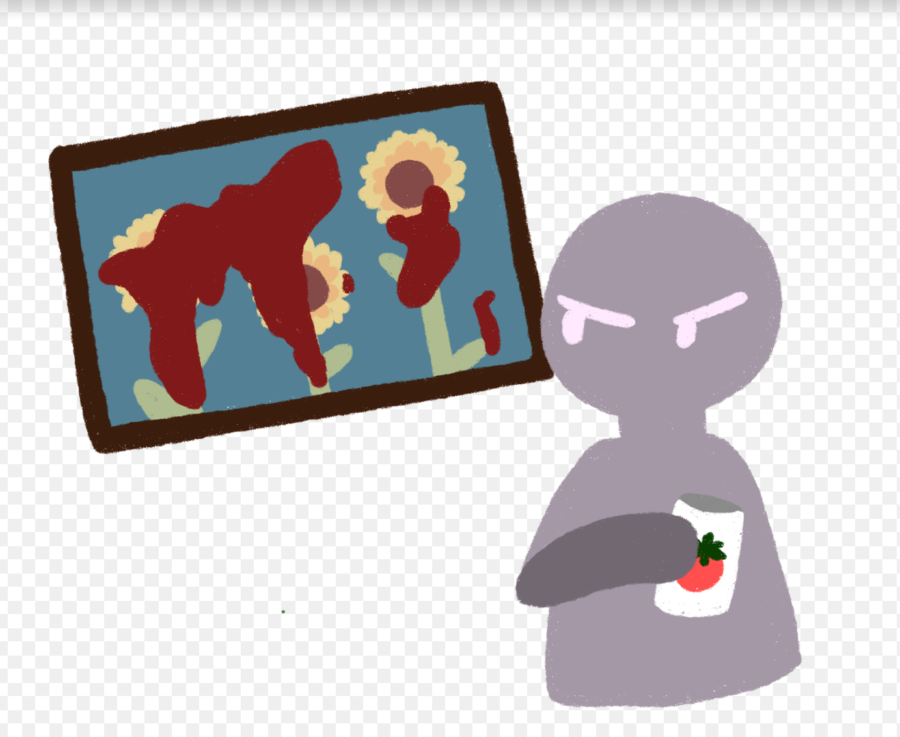Artists vandalize valuable art in the name of climate change
Despite the undeniable importance of this message, this activist tactic has had adverse effects, and negatively impacted the climate movement in general.
December 14, 2022
Just after 11 a.m. on October 14th, two activists of the Just Stop Oil Movement entered room 43 of London’s National Gallery, and, to the horror of many on-lookers, threw the contents of multiple tomato soup cans onto Vincent van Gough’s painting, Sunflowers. The demonstrators, Anna Holland and Phoebe Plummer, then glued their hands to the wall underneath the painting until they were arrested by Met police officers. As reported in The Guardian, while still in room 43, Plummer addressed the gathering crowd, asking them, “What is worth more, art or life?… Are you more concerned about the protection of a painting, or the protection of our planet and people?”
This particular demonstration is simply one of the many that have been organized by the Just Stop Oil movement. According to an article from the Smithsonian Magazine, the organization has used this tactic multiple times, including their June protest when activists glued their hands to the My Heart’s in the Highlands painting by Horatio McCulloch. The Just Stop Oil activist group is calling for the government to stop the collection of fossil fuels. More specifically, the recent soup demonstration was in protest of the U.K. government’s reversal of the 2019 ban on fracking. Despite the undeniable importance of this message, this activist tactic has had adverse effects, and negatively impacted the climate movement in general.
Undoubtedly, one of the main aims of this demonstration was to garner attention for the climate movement and make a powerful statement encouraging people to prevent the proliferation of tendencies that destroy our environment; in this respect it has succeeded. In the following week, hundreds of articles were published and went viral on multiple social media platforms. The attention towards the movement skyrocketed almost instantly. However, not all of this attention was positive.
This demonstration alienated many people who were not already engaged in the climate movement. Although an article from NPR reports that the London National Gallery made an announcement that the painting was not damaged due to the glass protection, many people saw this demonstration as unnecessary and over-the-top. Making pieces of renowned art victims of these demonstrations caused people to view the overall climate movement as irrational and extreme. Freshman Victoria Zhong said, “they got the attention and the publicity they wanted, but they also got an extremely bad reputation, even if the painting wasn’t damaged.” A main goal of many climate activists is to unify people under a common desire to protect our environment, but extreme actions like this one tend to have the opposite effect, creating a more polarized movement that discourages people from joining.
Proponents of this tactic argue that these efforts are necessary to achieve change, even if people become alienated in the process. Freshman Rosie Clemans-Cope said that, “people who don’t understand… how schools became integrated -civil rights protests-, or how LGBTQ+ people got human rights -starting with Stonewall-, would question the nonviolent tactics like throwing mashed potatoes on paintings protected by glass.” Activism that will eventually cause significant social changes will not use passive tactics, as passive activism will largely be ignored by governments and people. While this may be true, it’s also true that alienating possible sources of support makes it harder to achieve climate goals in the long term.
Activism has historically taken shocking and alternative forms in order to create meaningful, tangible change. Clemans-Cope also said, “nonviolent actions will always be a part of justice struggles,” and although using effective, nonviolent activism and spreading awareness is important, there are methods other than soup-throwing that can also create change. These alternative, less extreme methods would create much less division and unite more people under the climate movement, facilitating change through increased support. Climate change continues to be an extremely controversial political topic, and activists cannot afford to alienate groups that could potentially bring important financial and political support.
It is true that we need global legislative change and more action from global leaders and people in power in order to end the destruction of our earth. However, engaging in highly controversial activism that alienates significant portions of the public, thereby robbing the fight against climate change of significant support systems, is not helpful. Rather than using large publicity stunts in desperation for attention, activists should focus on influencing legislative changes and garnering positive attention for their cause. With the importance of the climate crisis, it is important to be cautious of the kind of tactics that are used.



